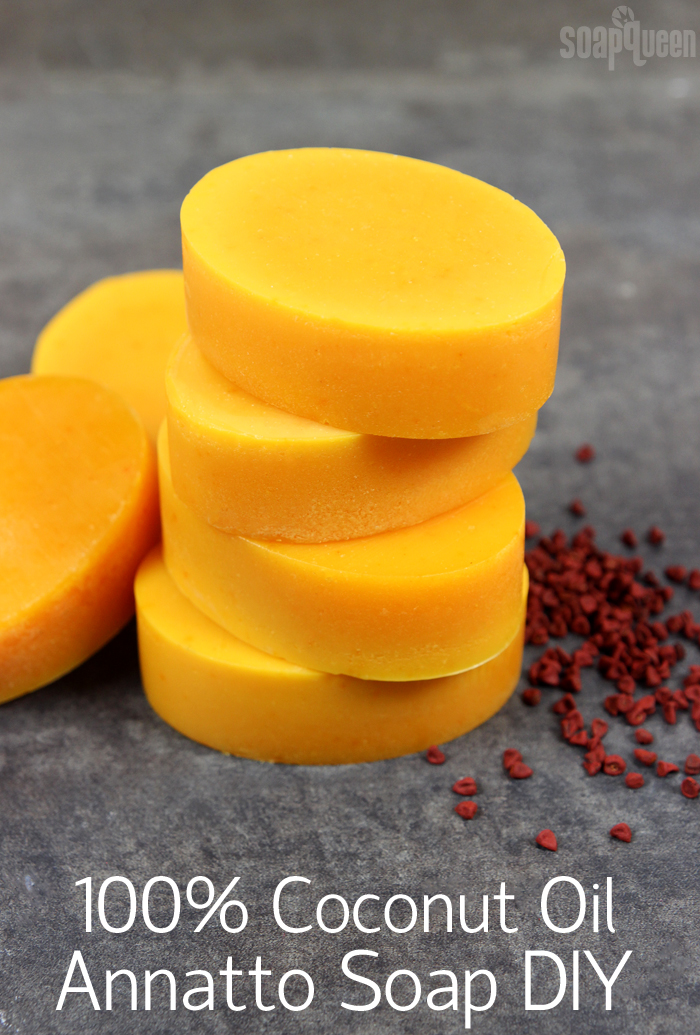
There are so many amazing uses for coconut oil. From creating lip balm to cold process soap, it’s fantastic for a variety of crafty beauty projects. In terms of cold process soap, I use it in just about every recipe.
While coconut oil is extremely hydrating when applied directly to skin, when combined with sodium hydroxide, it adds cleansing properties to cold process soap. If used at more than about 33% of the total recipe, it can make the bars feel too cleansing and can be drying to some. But, some soaping rules are meant to be broken! You can make soap out of 100% coconut oil if you have an unusually high superfat. Not sure what a “superfat” means? Long story short, it’s the amount of oils in a recipe that are not transformed into soap during the saponification process. An average superfat is usually between 1–7%. This means 1–7% of oils in the recipe are “free-floating” in the bar and were not turned into soap. A superfat is also referred to as a “lye discount.” This is because in order to turn fewer oils into soap, you reduce the amount of lye in the recipe. Still a little confused? This video may help.
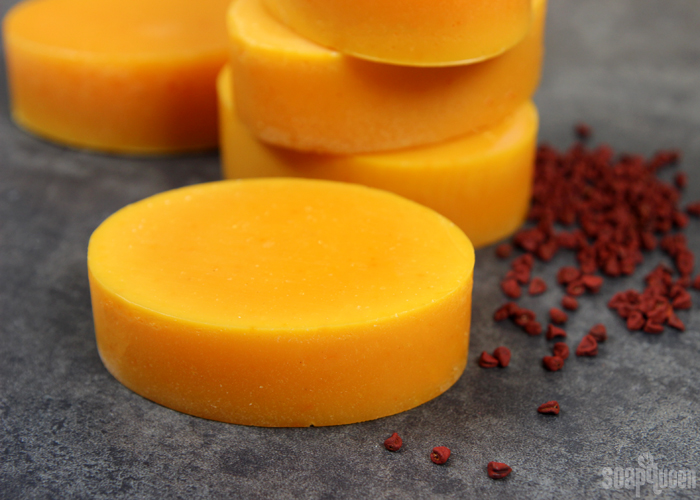
A high superfat of 20% combats the super-cleansing properties of soap made with only coconut oil. Because the Bramble Berry Lye Calculator doesn’t calculate a superfat that high (it’s something we are hoping to add), I’ll walk you through how I calculated this recipe. It’s super easy!
First, choose “Solid” for the type of soap. Then, select ounces or grams (whichever you prefer working with). Then, select a superfat of “None.” Click the “Next” button. Then, enter how many ounces or grams of coconut oil you’d like to use. In this case, I used 21 ounces. Click “Next.” The lye calculator gave me the recipe below.

Now, we are going to reduce the amount of lye in this recipe by 20%. This will create a 20% superfat. To reduce the lye by 20%, multiply the 3.74 ounces of lye by 0.8 (because we want 80% of the lye). This equals 2.992, which I rounded to an even 3 ounces for ease of weighing. Then, while it’s not necessary, I like to reduce the water amount by 20% to maintain the ratio of water and lye (otherwise, the soap can be pretty soft and gooey coming out of the mold initially). Multiply the 6.93 ounces of distilled water by 0.8. This equals 5.544, which I rounded to 5.5 ounces. Now you have the lye and water amounts to give this recipe a 20% superfat.
To keep these bars natural, I infused the coconut oil with annatto seeds for a bright orange color. I scented them with a blend of bergamot essential oil and litsea essential oil. It gives the soap a bright, citrusy scent that matches the orange hue. If you’re looking for more 100% coconut oil recipes, check out this 100% Coconut Oil Soap with Aloe Vera and Mantra Swirl by Kenna of Modern Soapmaking.
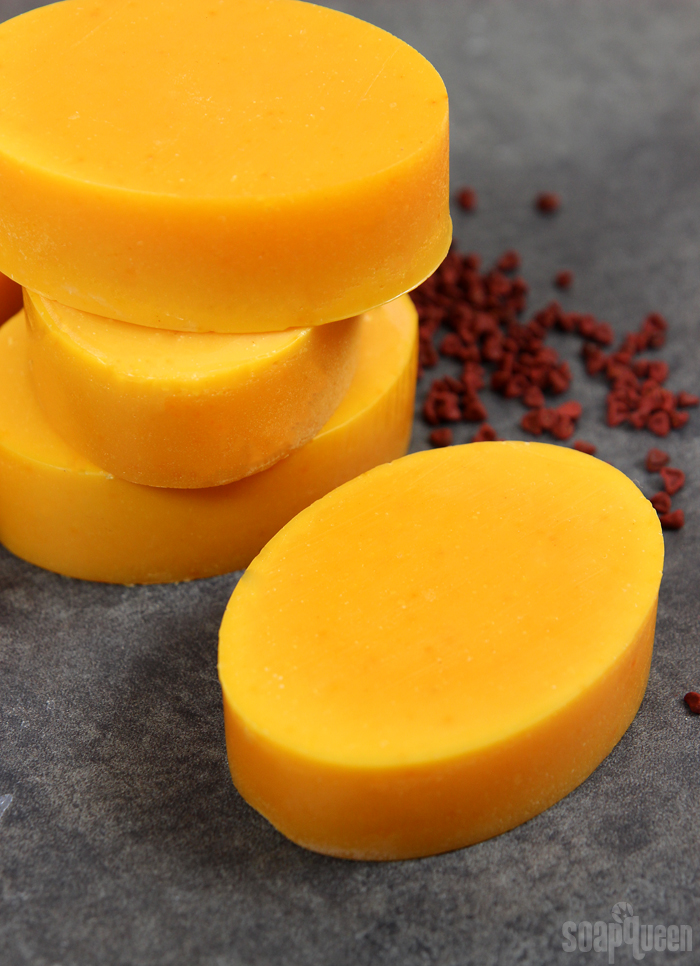
What You’ll Need:
6 Bar Oval Silicone Mold
21 oz. Coconut Oil
3 oz. Sodium Hydroxide Lye (20% lye discount)
5.5 oz. Distilled Water (20% water discount)
0.5 oz. Annatto Seeds
0.3 oz. Bergamot Essential Oil
0.5 oz. Litsea Essential Oil

Click here to add everything you need for this project to your Bramble Berry shopping cart!
If you’ve never made cold process soap before, stop here! I highly recommend checking out our FREE four part SoapQueen.tv series on Cold Process Soapmaking, especially the episode on lye safety. And if you’d rather do some reading, Bramble Berry carries a wide range of books on the topic, including my newest book, Pure Soapmaking. You can also checkout the digital downloads for that instant gratification factor.
INFUSE COCONUT OIL: First, we need to infuse the coconut oil with annatto seeds for color. There are several methods to infuse oils with annatto seeds, but for this project I used the “quick” method. Add 21 ounces of coconut oil into a heat-safe container. Place the container in the microwave, and heat the oils to about 160 ° F; be careful when removing the container from the microwave as it will be quite hot. Add the annatto seeds directly to the oil. Allow the annatto seeds to infuse the oil for about two hours, reheating the coconut oil in the microwave after the first hour. If you’d like, you can allow the annatto seeds to infuse the coconut oil for longer, which may result in a deeper color. I allowed my oil to infuse for about 2 hours, which created a nice bright orange color.
You can also infuse your coconut oil in a crock pot, click here for more information. Because coconut oil is a firm oil and hardens at cooler temperatures, I don’t recommend the cold oil infusion method for this recipe.
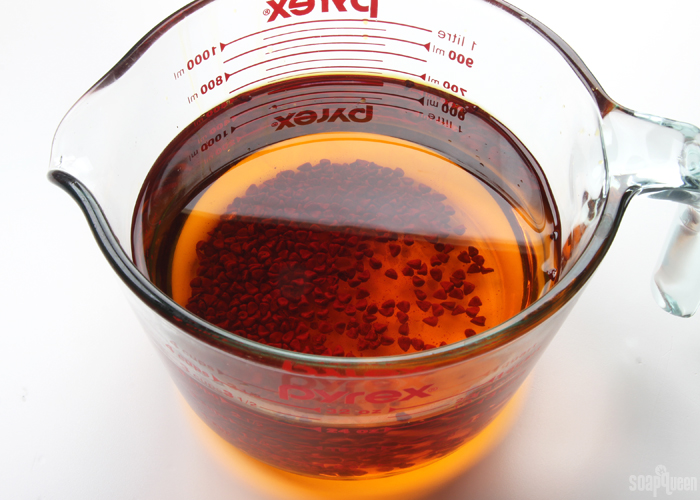
Pour the infused oil through a fine mesh strainer to remove the annatto seeds. Measure the amount of oil you’re left with; you may lose a small amount in the filtration process. If you have less than 21 ounces of coconut oil needed for the recipe, add more un-infused coconut oil to the container until you have the full 21 ounces. Set oil aside.
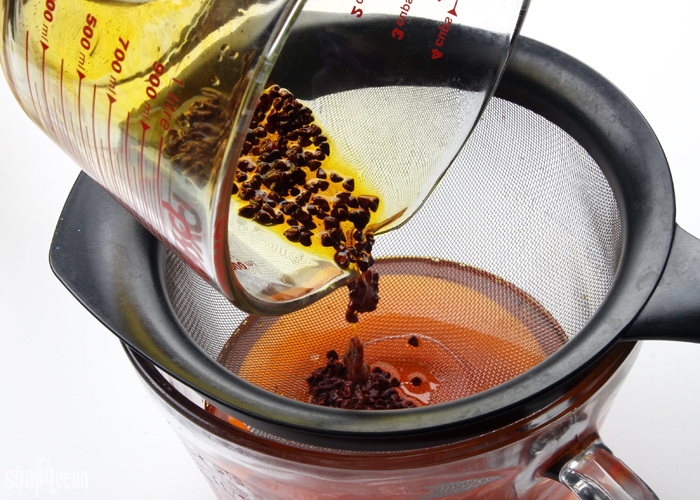 SAFETY FIRST: Suit up for safe handling practices! That means goggles, gloves and long sleeves. Make sure kids, pets, and other distractions and tripping hazards are out of the house or don’t have access to your soaping space. Always soap in a well-ventilated area.
SAFETY FIRST: Suit up for safe handling practices! That means goggles, gloves and long sleeves. Make sure kids, pets, and other distractions and tripping hazards are out of the house or don’t have access to your soaping space. Always soap in a well-ventilated area.
FRAGRANCE OIL PREP: In a glass essential oil safe container, mix together 0.3 ounce of bergamot essential oil and 0.5 ounce of litsea essential oil. Set aside.
ONE: Slowly and carefully add the lye to the water and gently stir until the lye has fully dissolved and the liquid is clear. Set aside to cool to about 130° F.
TWO: Fully melt and heat the annatto-infused coconut oil to 120-130 ° F. For this recipe, you need to soap on the warmer side to help prevent false trace. Read more about false trace here. Once the lye water and the oils have cooled to 120-130 ° F, add the lye water to the oils and stick blend until thin trace. Because this recipe is made from 100% hard oils, sodium lactate is not necessary for this recipe. The bars will be able to unmold within about 5-6 hours…maybe sooner!
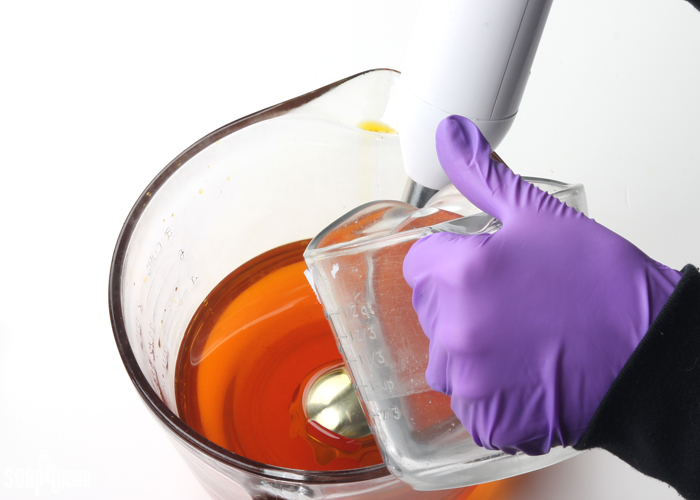
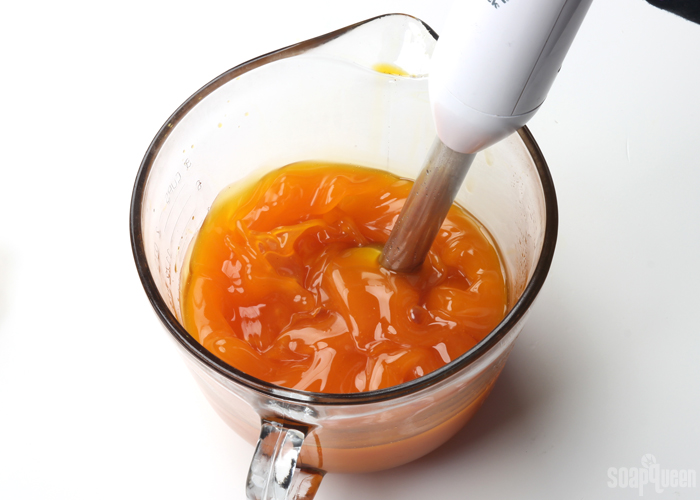
TWO: Once you have a very light trace, add the essential oil blend and stick blend in.
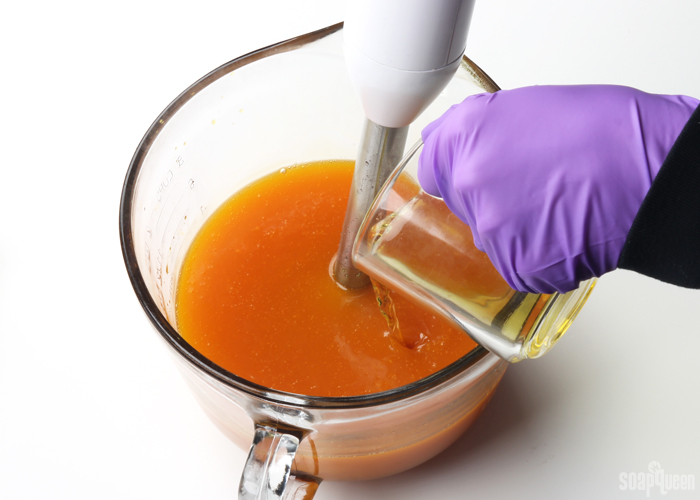
THREE: Continue to stick blend the mixture until you have a light trace and there are no oil streaks in the mixture. Alternate pulsing the stick blender and using it to stir the mixture throughout this step.
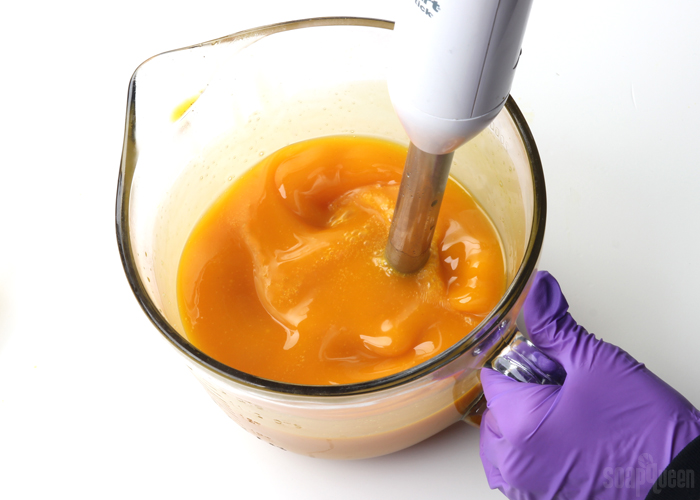
FOUR: Pour the soap into each mold cavity until full. Tap the mold on the counter to help release air bubbles. Spritz the top with 99% isopropyl alcohol to help prevent soda ash.
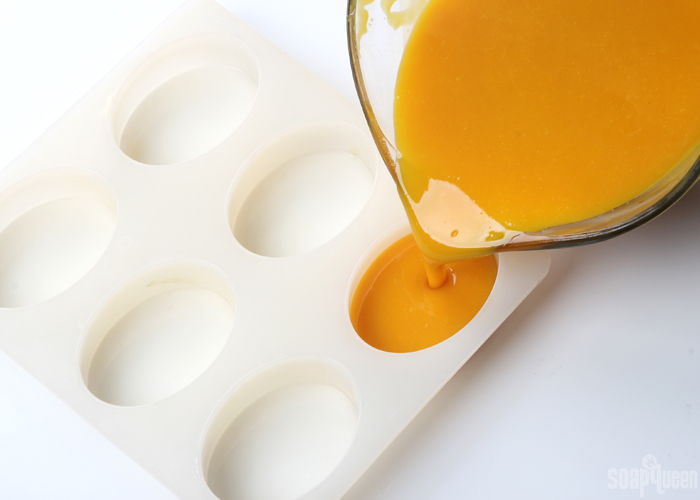
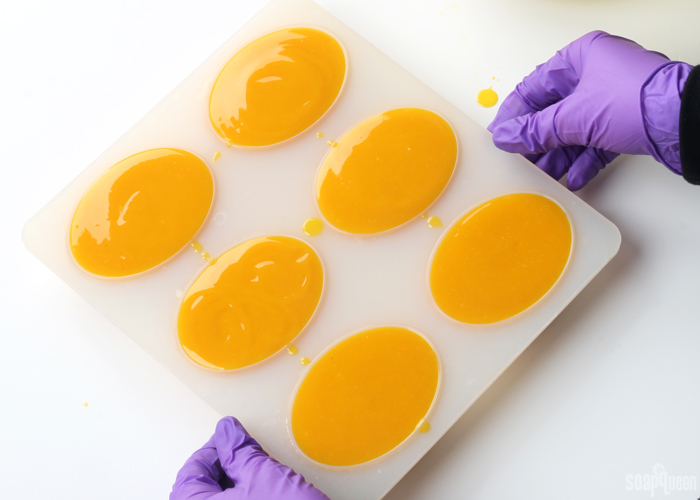
FIVE: Because this recipe requires a warmer temperature, this soap will have a tendency to gel. To help it go through a complete gel phase and avoid a partial gel in the center, place the mold on a heating pad on medium heat. Gelling this recipe will also help the color become more intense. Create a “cardboard tent,” and cover with a blanket to fully insulate. After about 30 minutes, turn off the heating pad and allow to stay insulated for several hours. If you live in a warmer or cooler climate, the soap may need more or less time on the heating pad.
Because this soap is made with only coconut oil, these bars can be removed from the mold very quickly! I would recommend giving them at least 6 hours to overnight to be on the safe side. Make sure you’re wearing gloves, as the bars are still saponifying and the lye can irritate the skin. To remove, gently pull the sides of the mold away from the soap to break the airlock, and push the soap out from the bottom. Once removed, use the Soap Shaver to clean up the bars. Allow to cure for 4-6 weeks to create an even firmer, more long lasting bar of soap.
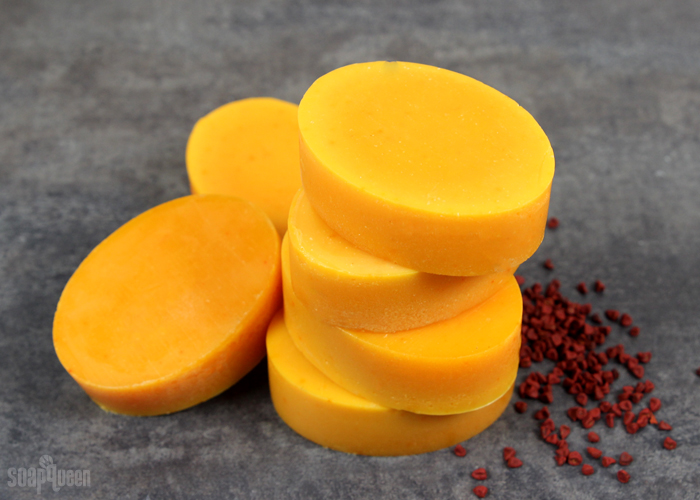
- 6 Bar Oval Silicone Mold
- 21 oz. Coconut Oil
- 3 oz. Sodium Hydroxide Lye (20% lye discount)
- 5.5 oz. Distilled Water (20% water discount)
- 0.5 oz. Annatto Seeds
- 0.3 oz. Bergamot Essential Oil
- 0.5 oz. Litsea Essential Oil
Pour the infused oil through a fine mesh strainer to remove the annatto seeds. Measure the amount of oil you’re left with; you may lose a small amount in the filtration process. If you have less than 21 ounces of coconut oil needed for the recipe, add more un-infused coconut oil to the container until you have the full 21 ounces. Set oil aside.
- Slowly and carefully add the lye to the water and gently stir until the lye has fully dissolved and the liquid is clear. Set aside to cool to about 130° F.
- Fully melt the annatto-infused coconut oil to 120-130 ° F. For this recipe, you need to soap on the warmer side to help prevent false trace. Read more about false trace here. Once the lye water and the oils have cooled to 120-130 ° F, add the lye water to the oils and stick blend until thin trace. Because this recipe is made from 100% hard oils, sodium lactate is not necessary for this recipe. The bars will be able to unmold within about 5-6 hours…maybe sooner!
- Once you have a very light trace, add the essential oil blend and stick blend in.
- Continue to stick blend the mixture until you have a light trace, and there are no oil streaks in the mixture. Alternate pulsing the stick blender and using it to stir the mixture throughout this step.
- Pour the soap into each mold cavity until full. Tap the mold on the counter to help release air bubbles. Spritz the top with 99% isopropyl alcohol to help prevent soda ash.
- Because this recipe requires a warmer temperature, this soap will have a tendency to gel. To help it go through a complete gel phase, and avoid a partial gel phase in the center, place the mold on a heating pad on medium heat. Gelling this recipe will also help the natural orange color become more intense. Create a “cardboard tent,” and cover with a blanket to fully insulate. After about 30 minutes, turn off the heating pad and allow to stay insulated for several hours. If you live in a warmer or cooler climate, the soap may need more or less time on the heating pad. Because this soap is made with only coconut oil, these bars can be removed from the mold very quickly! I would recommend giving them at least 6 hours to overnight to be on the safe side. Make sure you're wearing gloves, as the bars are still saponifying and the lye can irritate the skin. To remove, gently pull the sides of the mold away from the soap to break the airlock, and push the soap out from the bottom. Once removed, use the Soap Shaver to clean up the bars. Allow to cure for 4-6 weeks to create an even firmer, more long lasting bar of soap.
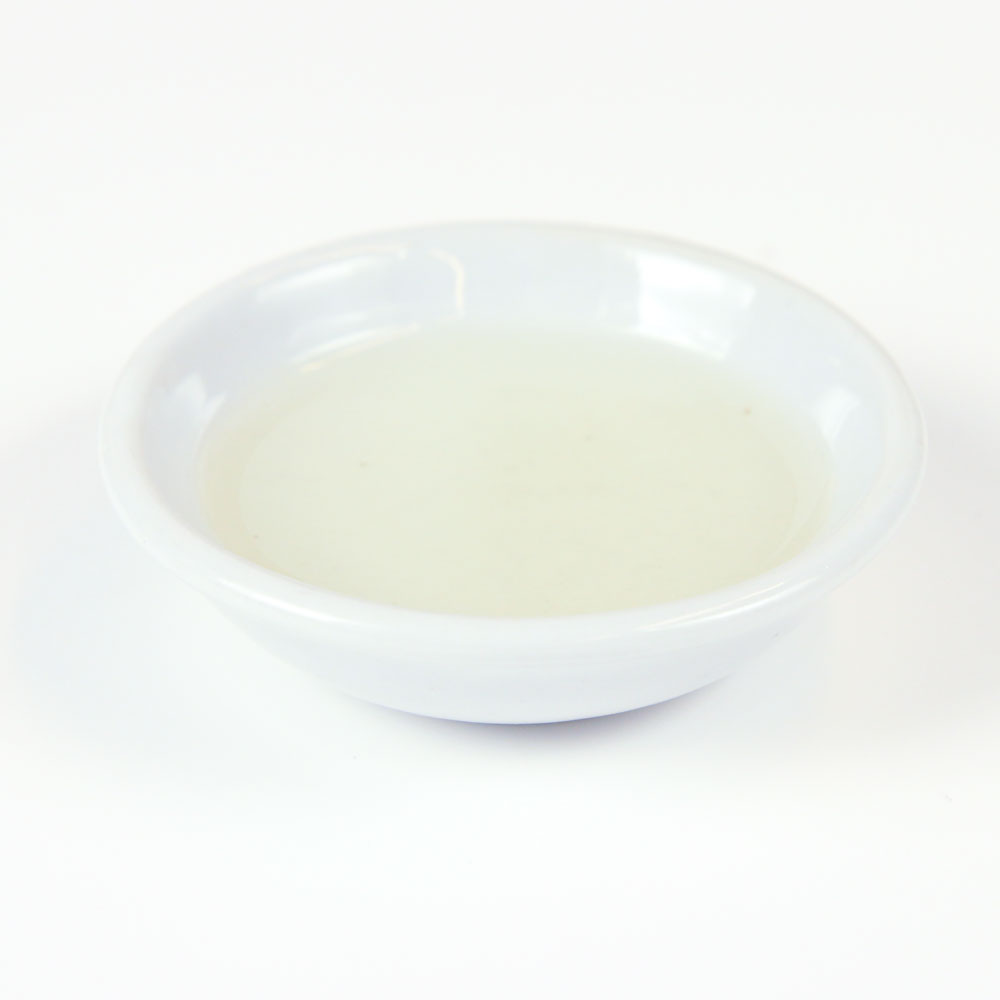

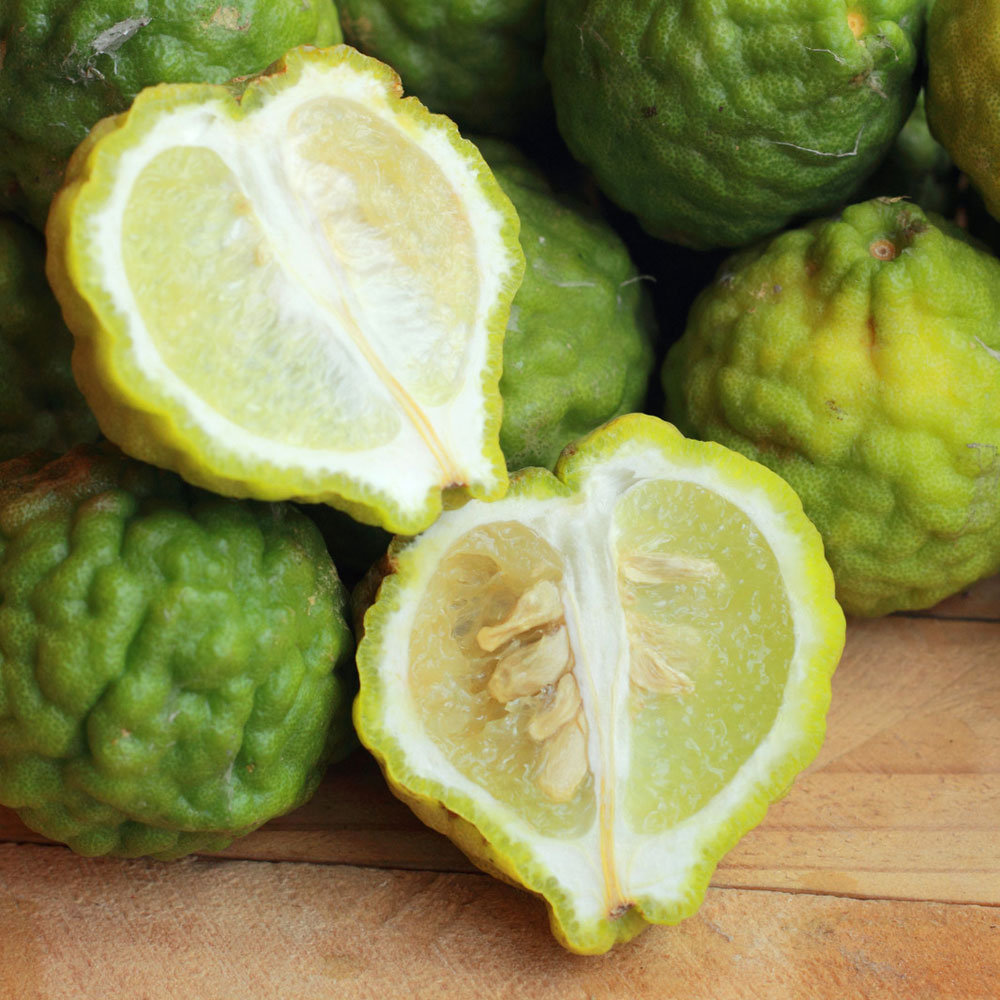


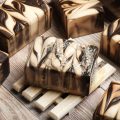

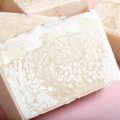
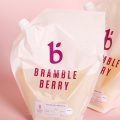
as I know, the more superfat > 5% the dilute will be cloudy, am I right?
if that so, is it fine as long as pH < 10?
Hello, I have a question in regards to a rancid coconut oil. Somebody gave me a large amount of rancid coconut oil which I would like to use in this recipe. However, since there is 20% superfatting, that means that not all of the oils will be made into soap, right? Is there a way to work around it, maybe making coconut oil soap with no superfatting, and then adding some other oil into it for a moisturizing properties? Thank you!
Using rancid oils may result in dreaded orange spots (DOS). If that occurs, your soap is still safe to use, but may not smell or look very good. This post has information on rancid oils: https://www.soapqueen.com/bath-and-body-tutorials/tips-and-tricks/shelf-life-bath-products-ingredients-rancidity-vs-mold/
If you want to create a coconut oil bar that has another type of oil in it too, you can plug the amount of coconut oil into the Bramble Berry lye calculator and then calculate the amount of superfatting you want with the calculator or by hand.
These posts will help you figure it out: https://www.soapqueen.com/bath-and-body-tutorials/cold-process-soap/superfatting-soap-an-explanation-2/
http://www.soapqueen.com/bath-and-body-tutorials/tips-and-tricks/free-beginners-guide-to-soapmaking-common-soapmaking-oils/
Hi…is this soap for sensitive skin?
Coconut oil is very cleansing, so it may be a bit harsh for sensitive skin. The 20% superfat does help make it more moisturizing. I would recommend making a small batch to see what you think.
Another option is Castile soap. It’s made with 100% olive oil, which is gentle and a good option for sensitive skin: https://www.soapqueen.com/bath-and-body-tutorials/castile-cold-process-soap-tutorial/
I made these today. I sprayed them with alcohol to prevent soda ash. Once they started to harden I noticed there was soda ash. How do I prevent this from happening next time?
I love the smell and the color of this. It makes my house smell amazing. I can’t wait to try it out.
Along with spraying alcohol, there are a few tricks to prevent soda ash. It helps to pour the soap when it’s warmer and thicker, and then keep it in a warm area while it hardens. Get more tips here: http://www.soapqueen.com/bath-and-body-tutorials/tips-and-tricks/explaining-and-preventing-soda-ash/
The good news is you can steam or wash away the soda ash with an old pair of nylons. The post I linked above shows you how.
What would the measurements be for a 3 Pound Silicone Loaf Mold. I’m new to cold process. I’m also a right arm amputee so it makes me uneasy using lye.
You can resize your recipe using our Lye Calculator. This post shows you how: https://www.soapqueen.com/bath-and-body-tutorials/tips-and-tricks/how-to-resize-cold-process-soap-recipes/
The oil weight for the 10″ Silicone Loaf Mold is 33 ounces.
As for the lye, it can be intimidating. However, as long as you take the recommended precautions it’s safe to use. This post talks more about that: https://www.soapqueen.com/bath-and-body-tutorials/tips-and-tricks/afraid-of-using-sodium-hyroxide-lye/
Thanks so much for the recipe! Can’t wait to use it as the base of my other soaps by adding different herbs/natural ingredients/essential oils to enjoy different skin benefits! Sorry it may be long asking 3 questions. I’m so excited to find this recipe I’ve been waiting for.
1. Can I infuse tea leaves using the same method here? If yes, how much tea would you recommend for this recipe?
2. I know this soap is hard and can crack easily if cut . If I make the soaps with individual molds, without cutting them, can I add oatmeal/tea leaves/powers… to enjoy exfoliating effect just like other soaps?
3. I see u suggested infusing annatto seeds powder with sweet almond oil if this is what we have, is it in any way possible to keep using only coconut oil? It’s because I super love this 1-oil simplicity of the recipe so much and I wish I can remain it, as well as when I do with other powder.
Thanks a lot for your help and time!
Yes, you can infuse tea leaves if you like. We recommend about 8 tablespoons of tea per pound of oil. Learn more about how to infuse tea here: https://www.soapqueen.com/bath-and-body-tutorials/tips-and-tricks/infuse-oil-tea-2/
You can add exfoliants and powders to this recipe. I would recommend a small test batch to see what you think. Because a 100% coconut oil recipe can be brittle, you may want to see how it works when dry powders and exfoliants are added.
You can use coconut oil to infuse the tea. We did that for this recipe using annatto and it worked well.
Hello.. I am very new to soapmaking and just recently made two batches of soap. The first one was made with Olive oil : coconut oil = 60 : 40 (0% superfat). While the second’s ratio was olive : coconut : palm = 60 : 20 : 20 (5% superfat).
The first loaf hardened nicely and i could cut it smooth and clean. The bars produce nice lather too (and yes a little dry feeling afterwards). Meanwhile the latter turned our to be much softer and more crumbly when i cut them. And it felt a bit oily in my hand. Also it smells not as good as the previous (i can smell quite strong oily aroma).
I happen to like the first ratio better and am thinking to give a 10% superfat to compensate for the dry feeling of the coconut oil. What do you think about it?
I live in Indonesia, down in the equatorial zone with highly humid atmosphere. Your site is much like my virtual in-depth textbook in Soapmaking. Thank you very much.
You can increase the superfat to 10% if you like, that will help with the dry feeling. You may also try changing the coconut to 30% and the olive oil to 70%, then you can do a 0-5% superfat. Both methods will add moisture to your recipe, so you may try both to see which one you like best.
-Kelsey with Bramble Berry
Wow thank you for your advice. It is reassuring. What effects should I anticipate from such high superfat? (beside the expected less dry soap). If I change the olive oil to 70%, how much longer will the curing time be? I am already impatient about the 4-6 weeks duration lol.
Actually I am also wondering about my 2nd batch. I thought with palm oil, it should’ve been firmer than the 1st one. I did add 2 tsp of honey and 2 tsp of salt to my 2 lbs soap (trying to substitute the sodium lactate). For coloring, i used another 2 tsp of turmeric powder dispersed at trace. Also I used frangipani essential oil in it. Did some of the ingredients make it a bit off?
Maybe you can enlighten something for me, Kelsey..
Thank you.
Higher superfat can make a soap softer to the touch – but since olive oil soaps typically get very hard once they are cured it shouldn’t be squishy or anything.
High Olive oil content can take longer to cure. So one way to combat that is to reduce the amount of water you use. That’s a more advanced technique – but it sounds like you are ready to experiement.
Honey can make a soap softer, so that might be the cause. It’s also possible that you just need to let that batch cure a little longer.
Hope this helps!
Hello Amber,
Wow. I keep learning new things about soap from people of brambleberry 😀
Thanks for the generous insights.
Warmest regards,
Ridhow
Hi – Thank you for the wonderful recipe. I am looking forward to trying it. I was hoping to play around with a bit by adding some exfoliants. Would you have any recommendations ?
Also is it possible to do a half and half soap with this recipe or does it harden too quickly? I was thinking, half with one colour, seperated by the exfoliant layer and half with another colour, topped with exfoliant powder? Would love to know your thoughts.
This recipe does move pretty quickly but you should have time to split it and add color. As for the exfoliants, sprinkling them in the middle may cause the soap to separate. You may want to make a small test batch to see if that happens. If so, you can add the exfoliants into the soap instead of in between. Learn more about exfoliants here: https://www.soapqueen.com/bath-and-body-tutorials/tips-and-tricks/all-about-exfoliants/
-Kelsey with Bramble Berry
Can I use the liquid annatto extract I use in cheese making? It is water that had food grade annatto seeds infused into it. If so, can I just add it in at trace like I would the infused oil?
I am so sorry to respond under your question but I couldn’t find where to add my question alone. I would love to try this but instead of using the seeds, I would love to add turmeric powder to my soap for a nice color. Would I just add the turmeric to my coconut oil and then microwave or add it in at trace? Also, I am thinking about adding ginger essential oil as my fragrance. How much should I add to it? I do not have a heating pad and curious as to how I can skip over that step? I’m not sure I quite understand how to cover it up. I will be using a 6 silicone triangle mold for this project. Can I just place the mold in a cardboard box, tape it and cover it with towels?
No worries Monica! You can mix the turmeric powder with a lightweight oil and add it at trace, or infuse the coconut oil. This post tells you how: https://www.soapqueen.com/bath-and-body-tutorials/tips-and-tricks/turmeric-cold-process-soap-color-tests/
You can use our Fragrance Calculator to find out how much ginger essential oil to add: https://www.brambleberry.com/Pages/Fragrance-Calculator.aspx
Also, the cardboard box will definitely work. Anything that keeps the soap nice and toasty will help encourage gel phase.
This post has more on insulating your soap: http://www.soapqueen.com/bath-and-body-tutorials/tips-and-tricks/when-to-insulate-handmade-soap/
-Kelsey with Bramble Berry
Hi Stacy! Does the annatto and water have any other additives? If so, it should be fine to use. Make sure to discount water from your main amount to account for the extra you’re adding at trace. So, if you add 1 ounce of infused water, subtract 1 from your lye and water mix. Also, you may want to make a small test batch to see if it works well.
-Kelsey with Bramble Berry
Thank you!
Hi would it be okay to make this in the 10 inch loaf mold and peak the top? Thanks 🙂
Absolutely, these bars will look really nice with some texture on the top. Coconut oil bars harden really quickly, so they need to be cut as soon as they’re hard otherwise they can crumble. That can be as short as a few hours. After one hour, check to see if the soap is firm to the touch. If so, cut the bars wearing gloves and let them cure like normal.
-Kelsey with Bramble Berry
I absolutely love this soap and everyone I have given it to loves it too. It’s the most gentle bar of soap I’ve made. The only downside is that I might have over-infused the annatto seeds with the oil because the lather is very orange. I used the heat method of infusion. Thanks for the recipe.
That’s awesome Rebecca, so glad you’re loving this soap! You can definitely use less annatto seeds for your next batch to prevent that color transfer. 🙂
-Kelsey with Bramble Berry
So this will have 20% superfat. Will the soap feel very oily? I ususally soap at 2% ???
If coconut oil is used at more than about 33% of the total recipe, it can make the bars feel too cleansing and can be drying to some. You can make soap out of 100% coconut oil if you have an unusually high superfat. The bars can feel a bit oily, but the cleansing properties of the coconut oil usually prevent any greasy feeling on the hands. You may want to make a small test batch to see what you think. If you’re not a fan, you can use a recipe with more soft oils and a 2% superfat. 🙂
-Kelsey with Bramble Berry
Thank you! I actually made a test batch for 3 bars. They look lovely!, but I have to wait to use them ….. Thank you for your reply!
If i use annatto powder, instead of seeds,will it dissolve? Will I still need to strain the oil? Thank you
The powder will infuse the oil with color nicely! Not all the powder may dissolve, so you’ll want to strain it through a cheesecloth or fine mesh strainer afterward to catch any leftovers. 🙂
-Kelsey with Bramble Berry
Love this recipe! The lather is great and the scent is amazing. I poured mine into sunflower molds, and it turned out great! This is a keeper.
That’s awesome, so glad you’re enjoying this recipe Kelly!
-Kelsey with Bramble Berry
I made this yesterday, with beautiful color results. Poured into BB’s silicone column mold, wrapped with a heating pad for 30 minutes (then turned off but left it wrapped) and let gel overnight. I awoke to a couple of “overheating” issues in the morning. There was a minor volcano on the top and some divoting on the sides. But, after slicing I was pleased with the end result…and that glorious smell (I used Orange 10x EO)! I think the divots caused by overheating actually enhanced the end product, which I called Orange Peel! (wish I could attach a photo for you here)
Oh that’s awesome, glad to hear it turned out well! If you like you can share a picture on our Facebook page. We love to see what people create. 🙂
Bramble Berry Facebook page: https://www.facebook.com/BrambleBerry/
-Kelsey with Bramble Berry
can we infuse annatto seeds into water and add water to solution after emulsification instead of infusing into oil
We haven’t given that a try, so I’m not entirely sure. However, you can infuse them in the lye water! Just add them when the water is hot. As the lye water cools, the seeds will color it. Then, you can strain the seeds out and add the lye water to your soap. You may want to make a small test batch to see how it works and how much to use for the color you’d like. 🙂
-Kelsey with Bramble Berry
For soap making do you recommend refined coconut oil or unrefined
You can use either! Refined coconut oil tends to be whiter and have a longer shelf life. That’s what we use. 🙂
-Kelsey with Bramble Berry
Thank you
I finally got around to trying this one and I’m glad I did. I received a free sample (thank you!) of electric lemonade cocktail and did a small batch (9 oz oil) and I love it and the scent oil. Then, I did the annatto seed infused 100% coconut oil soap with 20% superfat. I poured it into my BB silicone column mold and used BB apple sage scent. I posted the making video on youtube under theorgelmeister and the cured soap so I can show the amazing lather. Thanks for the recipe and I absolute WILL make another 100% coconut oil soap. It is awesome in the shower!
Thank you for offering such a nice recipe again! I’m currently infusing my coconut oil with annatto (powder). First time using this natural colorant. That’s so great about soaping; always something new to explore. Love it so much! I have a question though about the heating pad you mention. Can you point me in the direction where you can buy these? I live in The Netherlands and I only know of heating blankets, but they are quite big for such a little soap mold 😄 Thanks!
You’re welcome Zala, glad you’re enjoying the recipe! You should be able to find heating pads on Amazon. They’re often used for sore muscles, so you may also be able to find them at a drug store. If you can only find an electric blanket, that will work too. You can fold it up and set the mold on top. 🙂
-Kelsey with Bramble Berry
Thank you, Kelsey!
You’re right, I found them on the german Amazon website. Thanks!
In the meantime I’ve made this beautiful soap. Scented it with your Orange Blossom FO. Didn’t read the description beforehand, so wasn’t prepared for the accelleration. Was able to stay calm and glop it fairly well in the molds. My fault. With each batch something to learn 😀 We’ll see how it turns out tomorrow.
You’re welcome! Glad you were able to get the soap into the mold. Acceleration can definitely be surprising! The good news is it’ll smell really nice. Enjoy Zala. 🙂
-Kelsey with Bramble Berry
Orange Blossom Candle and Soap Fragrance Oil: https://www.brambleberry.com/Orange-Blossom-Candle-Soap-Fragrance-P2981.aspx
I plan to make this next week and I am putting it in your 12″ column mold. I have the recipe recalculated to fill it.
When would you suggest I remove and cut it into bars?
This recipe will harden fairly quickly because of the coconut oil! If you wait too long to cut it, it can crumble. I would recommend lightly tapping the soap after 2 hours (make sure to wear gloves!) If it’s firm to the touch, you can unmold and cut. If not, wait another hour and check again. 🙂
-Kelsey with Bramble Berry
I made this yesterday and the bars are lovely and already very hard. However, I noticed when cleaning up this morning that the soap residue left orange color on the paper towels. Is this going to be an issue when these are cured? Will the soap leave orange stains on washcloths and clothing?
That can sometimes happen if too much color is added. However, we found the amount recommended here doesn’t transfer! I would recommend letting it cure a couple more weeks and testing again. It may be that the soap itself is pretty soft still (especially with a high superfat), so you’re seeing soap residue. As it cures it should harden and not leave as much residue. If you find the color is still transferring, it is fine to use. You can also rebatch it with some uncolored soap to help dilute it. 🙂
Learn how to rebatch soap here: http://www.soapqueen.com/bath-and-body-tutorials/cold-process-soap/soap-queen-tv-presents-how-to-make-rebatch-soap-2/
-Kelsey with Bramble Berry
I made these the other day and even though I used ground Annatto seed to infuse the oil, they look exactly like your picture!
That’s awesome Jenna, so glad they turned out well! Enjoy – the lather is amazing. 🙂
-Kelsey with Bramble Berry
If I only have Annatto seed powder, how much would I use?
Because we didn’t test the powder in this recipe, I’m not entirely sure! I would recommend mixing 1 teaspoon of the powder into 1 tablespoon of a lightweight liquid oil like sweet almond. Then, add 1 dispersed teaspoon at a time until you get a lovely orange hue. The oil will help the annatto powder mix in smoothly and prevent clumps. 🙂
-Kelsey with Bramble Berry
Sweet almond oil: https://www.brambleberry.com/Sweet-Almond-Oil-P3205.aspx
Can I make this with cows milk instead of water? If so what temperature should I Soap at? Can I put in the freezer and avoid gel stage?
Making this recipe with milk is possible, but it may be a bit tricky. Because the coconut oil solidifies at 76F, if the milk is colder than that it will harden the oil before it’s fully mixed together. Instead I would recommend adding it at trace! You can add a couple ounces to get that creamy feeling. Just remember to discount that from your main water amount so the soap doesn’t get too wet. Then, pop it in the freezer for a couple hours to prevent scorching before removing to room temperature. 🙂
-Kelsey with Bramble Berry
I would love to add some coconut cream to this, just to through in some extra umph! I’m thinking I would do half the water, and add the other half (the cream) in at trace….Is that correct?
That would feel really lovely in this recipe! You can definitely add that at trace as long as there is enough water to fully dissolve the lye. If the lye is still cloudy or chunky after mixing, you’ll want to add more water until it’s fully clear (and subtract that from the cream amount). Also, because you’re adding less water initially, the soap will accelerate so be prepared to work fast! Then, to prevent the soap from scorching because of the natural sugar and fat in coconut cream, pop it in the freezer for a couple hours. Then, remove to room temperature for a couple more hours or up to overnight. The soap should be hard enough to cut by then. 🙂
-Kelsey with Bramble Berry
Hi, everybody. I’ve been curious about 100% coconut soap. I love a high percentage because of the awesome lather and I’ve used up to 50% with up to a 10% superfat. I may actually try it now, but in loaf form. With a 20% superfat should it be cut sooner than a traditional recipe? Why did you unmold your bars so soon and did they not develop soda ash on the other sides without alcohol since they still had unsaponified lye coming into contact with the air? Thanks for all your help and tips!
Because these bars are made with a hard oil, they will harden fairly quickly and be ready to unmold soon. They may still form soda ash, but several factors here prevented that. We soaped warm and poured the bars at a thick trace. Then, they were forced through gel phase. All of those factors help prevent soda ash. Read more about that here: http://www.soapqueen.com/bath-and-body-tutorials/tips-and-tricks/explaining-and-preventing-soda-ash/
-Kelsey with Bramble Berry
It looks wonderful. How does it lather? I would love to make this one.
This soap lathers really nicely! Coconut oil helps add cleansing and lathering properties to bar. Even with the high superfat it gives you big fluffy bubbles. 🙂
-Kelsey with Bramble Berry
Can I make 100% Grapeseed oil cold process soap?
Hi Clang!
We typically recommend adding grapeseed oil at 15% or less in the recipe. More than 15% can make the bars feel pretty soft and sticky. You can make 100% olive oil soap though! Learn how here: https://www.soapqueen.com/bath-and-body-tutorials/castile-cold-process-soap-tutorial/
And this post has more on common soapmaking oils and how much to use in your recipes: http://www.soapqueen.com/bath-and-body-tutorials/tips-and-tricks/free-beginners-guide-to-soapmaking-common-soapmaking-oils/
-Kelsey with Bramble Berry
I will definitely have to try this and I bet it smells amazing!
I think you’ll love it Deb! It smells so fresh and bright. 🙂
-Kelsey with Bramble Berry
“Because the Bramble Berry Lye Calculator doesn’t calculate a superfat that high…”
The app will let you go as high as you want. I like this tip, though — I’m not a math person, so I never would have figured this out on my own, as simple as it is.
That is correct, the Bramble Berry app does have more superfat options! That’s a great option for mobile users. 🙂
-Kelsey with Bramble Berry
Bramble Berry App: https://www.soapqueen.com/bramble-berry-news/bramble-berry-app-update/
this looks soooo yummy 🙂 I love the color
Thank you Iveta! Me too, I love warm colors. 🙂
-Kelsey with Bramble Berry
I’ve never tried a total coconut oil soap before, I’ll have to give this a try with some peppermint and eucalyptus leaves I have to use up.
That sounds like a great combination! Have fun Michael. 🙂
-Kelsey with Bramble Berry